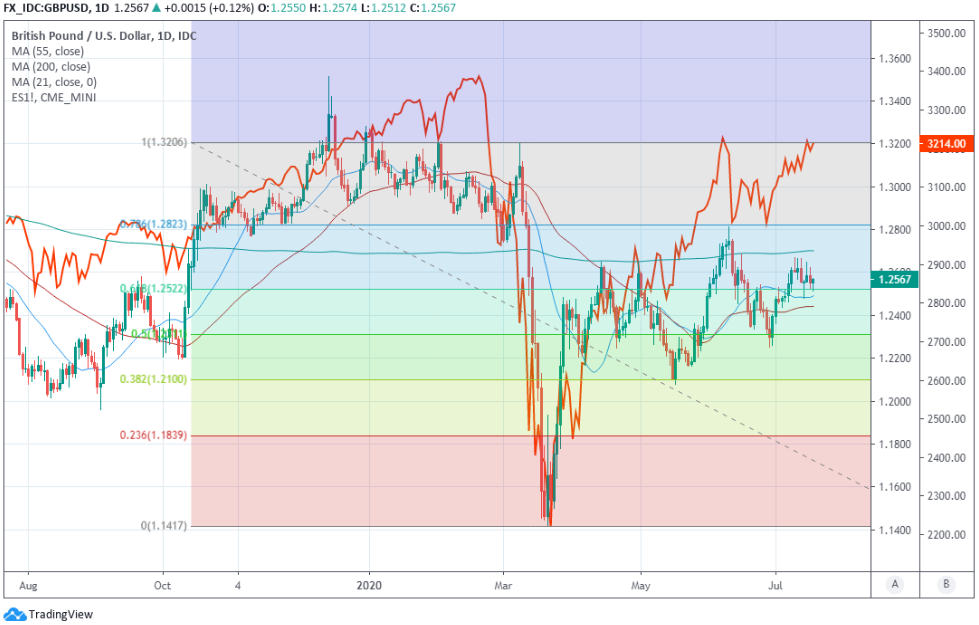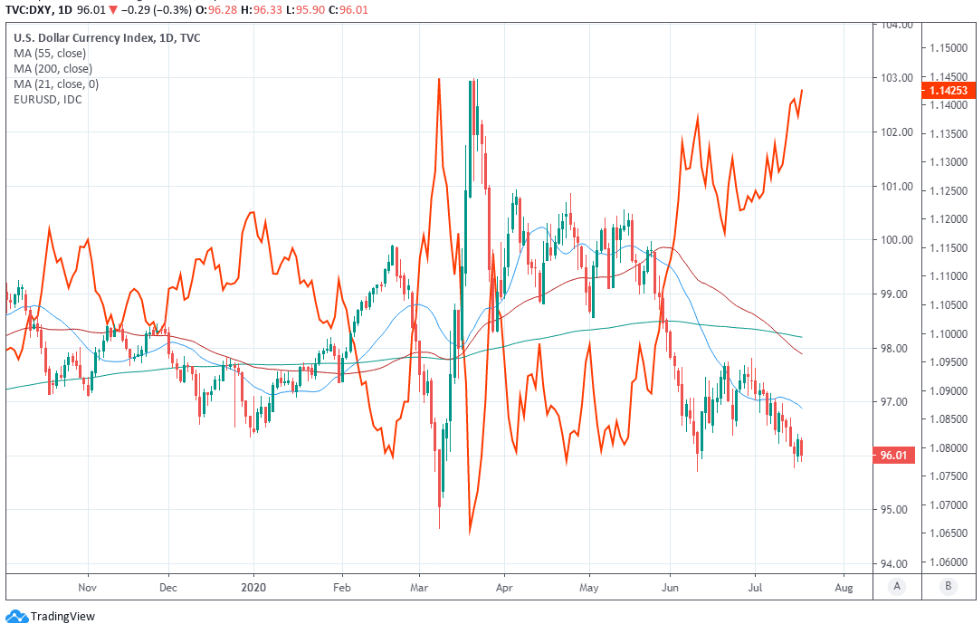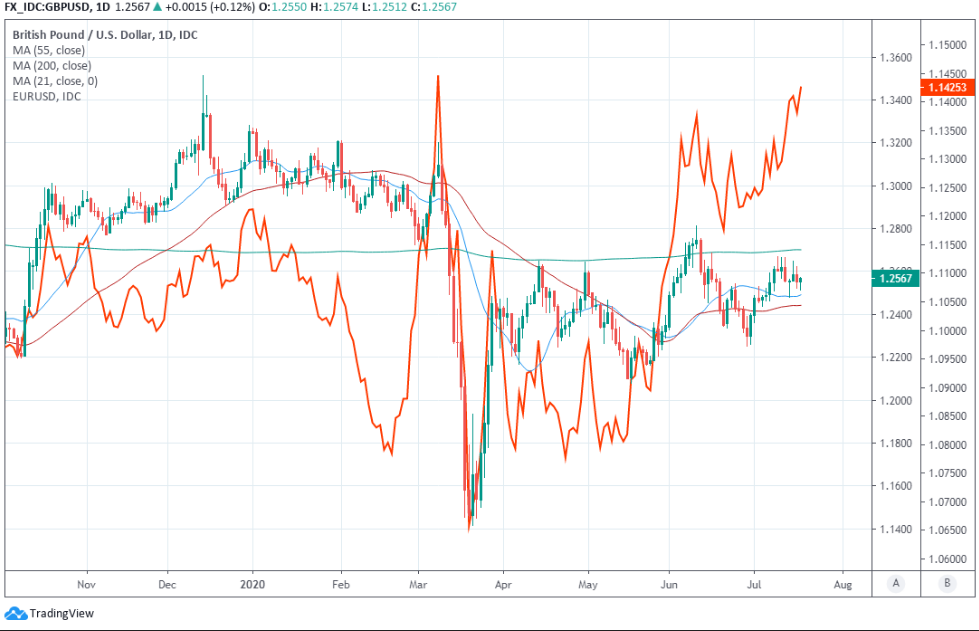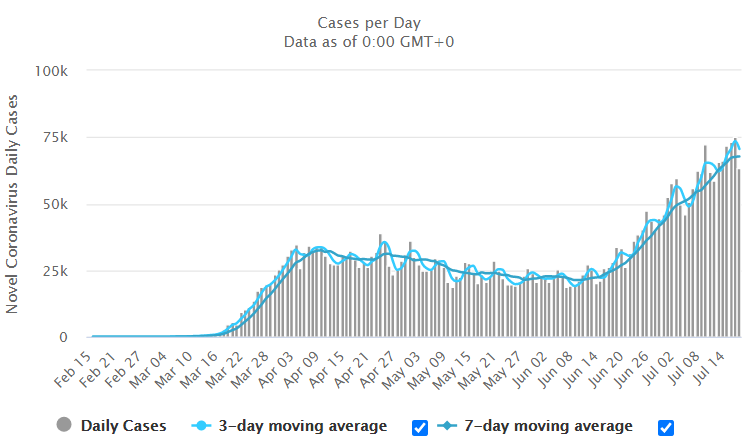Pound-Dollar Week Ahead: Charts Point Higher as Sentiment Sours, Stock Markets Set Direction
- Written by: James Skinner
- GBP slides even with USD out of favour, outlook on knife edge.
- USD weakness leaves charts and analysts pointing GBP higher.
- But investor sentiment, stocks, BoE, EU meeting possible pitfalls.

Image © Adobe Images
Achieve up to 3-5% more currency for your money transfers. Beat your bank's rate by using a specialist FX provider: find out how.
The Pound was one of only two majors that ceded ground to a troubled Dollar last week and will remain burdened by domestic headwinds in the coming days, although the response of stock markets to the latest corporate earnings will likely dictate the broad trajectory of Sterling.
Sterling fell further from favour last week after a May economic bounceback failed to show up in Office for National Statistics data and the Bank of England (BOE) revived concerns about a policy pivot to negative interest rates.
Monetary Policy Committee member Silvana Tenreyro said the idea remains under review at the BoE, helping send the Pound to the bottom of the major currency bucket even with risk appetite evidently robust, which enabled stock markets to advance and hounded the Dollar back to March lows.
The Pound-to-Dollar rate was -0.50% lower for the week when it closed at 1.2567 Friday, placing it behind even the New Zealand Dollar, which was also an underperformer alongside the greenback.
"2-year gilt yields fell below JGBs' this week, and there is still no visible progress on a trade deal with the EU," says Kit Juckes, chief FX strategist at Societe Generale. "The UK released strong BRC sales data for June, and weaker than expected data on GDP, industrial production, services output, and construction, for May. Labour market data show weak employment, and unemployment falling but only because many workers are withdrawing from the market."
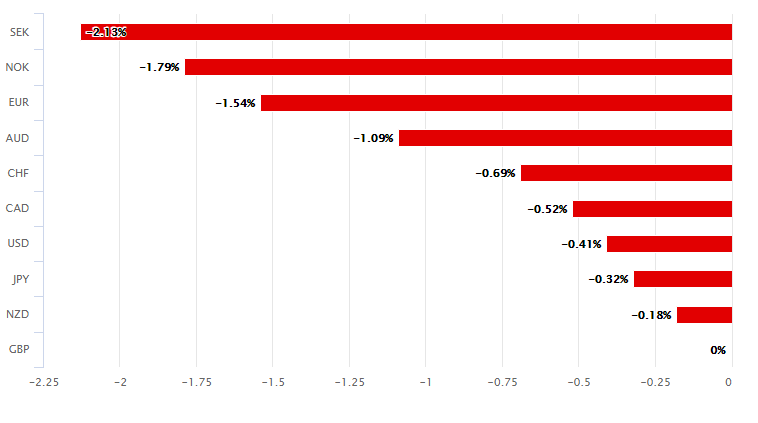
Above: Pound Sterling performance against major rivals last week. Source: Pound Sterling Live.
Technical and fundamental analysts suggest the Pound-to-Dollar rate has scope to rise from current levels given the increasingly dire outlook for the greenback, although with stock markets testing their June highs, Sterling will almost certainly need the rally in the S&P500 to endure.
That leaves the Pound-to-Dollar rate as dependent on the response to quarterly numbers as it is anything else, which include Tesla on Wednesday as well as Twitter and Amazon on Thursday.
"The active debate on negative rates could come into sharper focus into the August MPC, where our economists think the BoE will revise down its estimate of the lower bound, probably in the form of a qualitative description (“now moderately negative”)," says Zach Pandl, global co-head of foreign exchange strategy at Goldman Sachs. "Given our generally constructive market outlook we are still forecasting cable upside (with a 3-month target of 1.28), but acknowledge the negative rate debate could be a near-term headwind."
Pandl says the lagging recovery in the UK and lack of ambition in the trade talks with the EU are a recipe for underperformance that's made more potent by the BoE's ongoing contemplation of a negative interest rate policy.
This means Monday's 16:10 appearance before the Treasury Select Committee by the BoE's Tenreyro and chief economist Andy Haldane will likely be scrutinised closely by the market.
Above: Pound-to-Dollar rate at daily intervals with Fibonacci retracements of March fall, S&P 500 futures (orange line) and 21, 55 (red) and 200-day (green) moving-average.
“GBPUSD remains range bound but spot has been pressing up against well-defined trend resistance at 1.2641 whilst finding support against the 40-day MA in July which suggests some underlying strength in the market at this point. Recall that weekly price signals are more GBP-supportive after the late June/early July rebound from the low 1.23 area. Support here remains crucial for the GBP, with price action since the March low taking on the form of a possible—albeit somewhat extended—Head & Shoulders pattern,” says Juan Manuel Herrera, a strategist at Scotiabank. “We still rather think a move above 1.28 or below 1.23 is needed to inject a little more dynamism in this market. We are leaning towards a topside break but with not too much conviction.”
Goldman Sachs also notes the positive relationship the Pound has with stock markets that have proven resilient to a second wave of coronavirus in the U.S., a still-growing pandemic and tensions between the world's two largest economies. It has a three-month target of 1.28 for Sterling but much of this envisaged upside results from expectations of protracted Dollar weakness.
Technical analysts at Scotiabank and Commerzbank are also looking for further gains by the Pound-to-Dollar rate in the short-term, but with the greenback at four-month lows ahead of earnings reports from some of America's largest technology names set to report earnings this week, the short-term outlook for Sterling is balanced on a knife edge.
"GBP/USD has come close to but so far remains below the 1.2699/1.2709 resistance area which consists of the 200 day moving average and the eight month resistance line. Further up sits the June peak at 1.2814. Immediate upside pressure will be maintained while the currency pair remains above the 1.2480 July 14 high on a daily chart closing basis,” says Axel Rudolph, a senior technical analyst at Commerzbank, who has a neutral-to-positive outlook for the Pound-to-Dollar rate so long as it remains above 1.2072.
Above: Dollar Index shown at daily intervals with Euro-to-Dollar rate (orange), 21, 55 (red) & 200-day (green) averages.
The Pound's litany of domestic headwinds are enough to ensure it underperforms on the good days and the bad and will condemn it to further losses in the months ahead without progress toward a trade agreement in the Brexit negotiations or signs of a stronger economic recovery. But the Pound-to-Dollar rate could also be weighed down on Sunday and Monday by disappointment over the outcome of the special European Council meeting.
"Equities continue to prove a quiet contained sensitivity to both the surge in US Covid-19 cases and geopolitical tensions. Gauging the magnitude of the economic recovery remains pivotal for market sentiment and the safe-haven dollar," says Chris Turner, head of markets and regional head of research at ING. " GBP/USD would likely tick higher mainly driven by the rise in the EUR/USD, with a limited potential for GBP/USD to outperform EUR/USD as GBP still faces the well-known headwinds (the future of the EU-UK relationship) which does not advocate a bullish GBP case for months to come."
The meeting overran into Sunday as leaders debated a revised proposal from European Council President Charles Michel, who suggested reducing the grant contingent of the €750 billion recovery fund from €500bn to €450bn.
Talks remained deadlocked, with Chancellor Angela Merkel reported to have said that another meeting might be necessary.
"GBP/USD remains confined within an short-term uptrend chancel with the $1.24-$1.25 base supporting, and the $1.27 acting as a target/stiff resistance to the topside, which if broken, could quickly see the $1.28-$1.29 range come into play," says George Vessey, a strategist at Western Union Business Solutions. "Should EU divisions dominate, then the Euro is expected to depreciate. EUR/USD may retrace towards $1.12 and this could drag on GBP/USD to the lower bounds of the aforementioned range."
Above: Pound-to-Dollar rate at daily intervals with EUR/USD (orange line), 21, 55 (red) and 200-day (green) moving-averages.
The prospect of a large fiscal response and scope for greater European coordination on such matters has been key to the recent improvement in sentiment toward the Euro, but EUR/USD could find itself vulnerable if the odds of an agreement are seen lengthening this week or through the remainder of summer. The fund must be approved unanimously alongside the next seven-year EU budget and is intended to become operational from January 2021.
Beyond the Monday open Sterling's attention will turn back to the Brexit negotiations where an update from negotiators is expected on Thursday or Friday, and economic data.
"New infections are increasing dramatically. This will slow the economy's recovery, but it is unlikely to trigger a new downturn. At the same time, the relatively poor picture the US presents in the pandemic is likely to weigh on the dollar," says Bernd Weidensteiner, an economist at Commerzbank.
Meanwhile, and with stock markets aside, the Dollar may be sensitive to any moves in Washington to organise an extension of fiscal support payments under the CARES Act which is set to expire at month-end, in addition to domestic coronavirus developments as well as the ebb and flow of geopolitical tensions.
The U.S. set records for new infections repeatedly last week and if recent rates of growth are sustained in the coming days this week will see America surpass the 4 million threshold. The resurgent virus is harming confidence, leading to reimposed restrictions and as a result is holding back the U.S. recovery although progress toward another fiscal support package or signs of a slowdown in the U.S. second wave might be enough to steady the Dollar.
"The most straightforward hurdle to a weaker U.S. dollar is a double whammy of this COVID-19 resurgence creating a W-shaped recovery coupled with any failure by the U.S. Treasury/Trump administration and/or U.S. Congress to bring fresh stimulus measures," says John Hardy, head of FX strategy at Saxo Bank. "The sterling technical outlook is finely balanced (a move and close above 1.2700 needed to excite upside interest in GBPUSD)."
Above: Number of new coronavirus infections declared each day in the U.S. Source: Worldometers.

